Probability and Statistics for Engineering and the Sciences 8th Edition Chapter 2 Probability
Page 54 Problem 1 Answer
Given:1,2,3 and 4 universities are participating in a holiday basketball tournament. In the first round, 1 will play 2 and 3 will play 4.
Then the two winners will play for the championship, and the two losers will also play. To list all the possible outcomes in S.
We shall first consider for university 1 and see the possible outcomes and then similarly we will have the possible outcomes for all the other universities.
Four universities 1,2,3 and 4 are participating in a holiday basketball tournament.
Let’s assume that the university 1 wins the holiday basketball tournament which means that 1 beats 2 in the first game.
Now the second game university 3 can beat university 4 and university 4 can beat university 4
Therefore, all outcomes where university 1 wins the holiday basketball tournament will be
{1324,1342,1423,1432} in the similar way we obtain the outcomes when university 2 wins, university 3 wins and university 4 wins the holiday basketball tournament.
Therefore we obtain the sample space as:
S={1324,1342,1423,1432,2314,2341,2413,2431,3124,3142,3214,3241,4123,4132,4213,4231}
The list of all the possible outcomes is S={1324,1342,1423,1432,2314,2341,2413,2431,3124,3142,3214,3241,4123,4132,4213,4231}.
Page 54 Problem 2 Answer
Given:1,2,3,4 universities are participating in a holiday basketball tournament. In the first round, 1 will play 2 and 3 will play 4.
Then the two winners will play for the championship, and the two losers will also play.
Given:A denotes the event that 1wins the tournament.To list all the outcomes in A.
We will check for all the possibilities where the university 1will win the tournament.
Four universities 1,2,3 and 4 are participating in a holiday basketball tournament.
Let’s assume that the university 1 wins the holiday basketball tournament which means that 11 beats 2 in the first game.
Now the second game university 3 can beat university 4 and university 4 can beat university 4 Therefore, all outcomes where university 1 wins the holiday basketball tournament will be
A={1324,1342,1423,1432}
Outcomes of event A is A={1324,1342,1423,1432}
Page 54 Problem 3 Answer
Given: 1,2,3 and 4 universities are participating in a holiday basketball tournament. In the first round, 1 will play 2 and 3 will play 4.
Then the two winners will play for the championship, and the two losers will also play.
Given: B denotes the event that 2 gets into the championship game.
To list all the outcomes in B We will check for all the possibilities where the university 2 gets into the championship game.
Now the university 2 gets into the championship game means that the university 2 wins first round game but they can still lose the championship game.
Therefore, we get: B={2314,2341,2413,2431,3214,3241,4213,4231}.
The list of outcomes in B is: B={2314,2341,2413,2431,3214,3241,4213,4231}.
Page 54 Problem 4 Answer
A denotes the event that 1 wins the tournament.
B denotes the even that 2 gets into the championship game.
Obtained sample space: S={1324,1342,1423,1432,2314,2341,2413,2431,3124,3142,3214,3241,4123,4132,4213,4231}
Obtained outcomes of A and B:A={1324,1342,1423,1432}
B={2314,2341,2413,2431,3214,3241,4213,4231}
To find A∪B and in A∩B.To find the outcomes of A′.
We will use the definitions to find the required values.
We haveA={1324,1342,1423,1432}
B={2314,2341,2413,2431,3214,3241,4213,4231}
Therefore the list of outcomes which in A,B or both are:
A∪B={1324,1342,1423,1432,2314,2341,2413,2431,3214,3241,4213,4231}
The list of outcomes which is contained in both A and B are : A∩B=∅
Since there is no outcome common to both.
We have S={1324,1342,1423,1432,2314,2341,2413,2431,3124,3142,3214,3241,4123,4132,4213,4231}
And A={1324,1342,1423,1432}
Hence the list of outcomes which in S and not in A is: A′
={2341,2413,2431,3124,3142,3214,3241,4123,4132,4213,4231}
We obtain:A∪B={1324,1342,1423,1432,2314,2341,2413,2431,3214,3241,4213,4231}
A∩B=∅A′={2341,2413,2431,3124,3142,3214,3241,4123,4132,4213,4231}
Page 54 Problem 5 Answer
Given figure of the system:

Given: The sub-system will function if at least one of the two individual components functions.
To find the outcomes contained in event A that exactly two out of the three components function.
We will check for all the possibilities for the given condition.
Exactly two out of the three components are functioning means that we should have exactly two letters S in the events and one latter F, therefore, all outcomes contained in the event A is A={SSF,SFS,FSS}
The outcomes with two functioning and one nonfunctioning component is: A={SSF,SFS,FSS}
Page 54 Problem 6 Answer
Given figure of the system:

Given: The sub-system will function if at least one of the two individual components functions.
To find outcomes are contained in the event B that at least two of the components function.
We will check for all the possibilities for the given condition.
At least two of the components function means that it could be possible that all three function or exactly two are functioning that is the event B
B={SSS,SSF,SFS,FSS}
The list of outcomes are contained in the event B that at least two of the components function is:
B={SSS,SSF,SFS,FSS}.
Page 54 Problem 7 Answer
Given figure of the system:

Given: The sub-system will function if at least one of the two individual components functions.
To find outcomes that are contained in the event C that the system functions.
We will check for all the possibilities for the given condition.
Now we have that the system functions if the component 1 functions (meaning that S has to be in the first place) and one of the other two has to work (meaning that at least one S
should be in second and third place).
Therefore we get: C={SSS,SFS,SSF}
The outcomes where the system functions are C={SSS,SFS,SSF}
Page 54 Problem 8 Answer
Obtained values of event A,B and A are
A={SSF,SFS,FSS}
B={SSS,SSF,SFS,FSS}
C={SSS,SFS,SSF}
To list the outcomes: C′,A∪C,A∩C,B∪C, and B∩C
We will use the definitions to find the required values
We know that C′ is the complement of C which imply that system is not functioning.
We need to list all the outcomes which are not functioning forC′
Hence we get C′={FSS,FSF,FFS,FFF,SFF}
In order to calculate A∪C we need to list all outcomes which are in A or C. So, we getA∪C={SSS,SSF,SFS,FSS}.
In order to calculate A∩C we need to list all outcomes which are in A and C. So, we get A∩C={SSF,SFS}.
In order to calculate B∪C we need to list all outcomes which are in B or C. So, we get B∩C={SSS,SSF,SFS}.
In order to calculate B∩C we need to list all outcomes which are in B and C. So, we get B∩C={SSS,SSF,SFS}.
We obtain:
C′={FSS,FSF,FFS,FFF,SFF}
A∪C={SSS,SSF,SFS,FSS}
A∩C={SSF,SFS}
B∩C={SSS,SSF,SFS}
B∩C={SSS,SSF,SFS}
Page 55 Problem 9 Answer
Given: A college library has five copies of a certain text on reserve. Two copies (1 and 2) are first printings, and the other three (3,4 and 5) are second printings.
A student examines these books in random order, stopping only when a second printing has been selected.
To list all the possible outcomes in S We will write the sample space in tabular form.
The sample space for choosing the books is as follows:
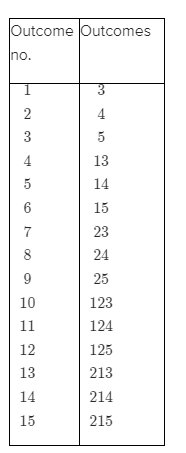
When creating the table, you can always start with all the same letters and go down, this is a classic method for creating the table.
The outcomes in S is given as:

Page 55 Problem 10 Answer
Given: A college library has five copies of a certain text on reserve. Two copies (1 and 2) are first printings, and the other three (3,4 and 5) are second printings.
A student examines these books in random order, stopping only when a second printing has been selected.
To list the outcomes of A which denote the event that exactly one book must be examined.
We will make use of the sample space.
The sample space table is given as:

We need to select the book from second printings in order to stop the selection.
By observing the sample space from the table , we get A=1,2,3 or A=3,4,5.
The outcomes in event A can be any one of 1,2,3 or 3,4,5.
Page 55 Problem 11 Answer
Given: A college library has five copies of a certain text on reserve. Two copies (1 and 2) are first printings, and the other three (3,4 and 5) are second printings.
A student examines these books in random order, stopping only when a second printing has been selected.
To list the outcomes of B which denote the event that book 5 is the one selected.
We will make use of the sample space.
The sample space table is given as:

With the help of the sample space observed in the table, we can see if the book5 is selected then the last selection number must be 5 as the student will stop selecting when he/she selects the copy5
Hence, the outcomes are 3,6,9,12,15 or 5,15,25,125,215
The outcomes of event B can be 3,6,9,12,15 or 5,15,25,125,215
Page 55 Problem 12 Answer
Given: A college library has five copies of a certain text on reserve. Two copies (1 and 2) are first printings, and the other three (3,4 and 5) are second printings.
A student examines these books in random order, stopping only when a second printing has been selected.
To list the outcomes of C which denote the event that book 1 is not examined.
We will make use of the sample space.
The sample space table is given as:
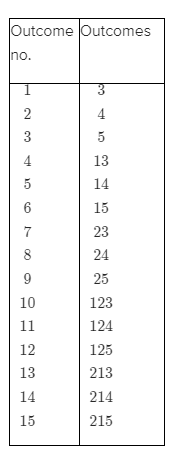
With the help of the sample space observed in the table, we can easily check for all the outcomes which do not contain 1.
Hence, the outcomes can be1,2,3,7,8,9 or 3,4,5,23,24,25
The outcomes of event C can be 1,2,3,7,8,9 or 3,4,5,23,24,25
Page 55 Problem 13 Answer
Given: An engineering construction firm is currently working on power plants at three different sites.
LetA{i} denotes the event that the plant at site i is completed by the contract date.
Given event: At least one plant is completed by the contract date.
To use the operations of union, intersection, and complementation to describe each of the following events in terms of A{1},A{2}, and A{3}
To draw a Venn diagram, and shade the region corresponding to the given event.
In order to show that at least one plant from A1,A2 and A3 and is completed by the contract date, we will define an event which is denoted as A1∪A2∪A3.
The Venn Diagram is given below:
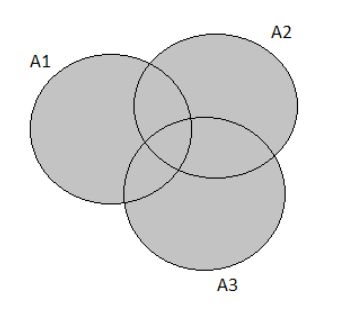
The event that at least one plant is completed by the contract date is given by: A1∪A2∪A3
The required Venn diagram is:

Page 55 Problem 14 Answer
Given: An engineering construction firm is currently working on power plants at three different sites.
A{i} denotes the event that the plant at site i is completed by the contract date.
Given event: All plants are completed by the contract date.
To use the operations of union, intersection, and complementation to describe each of the following events in terms of A{1},A{2}, and A{3}
To draw a Venn diagram, and shade the region corresponding to the given event.
In order to get all plants completed by the contract data, we require A1∩A2∩A3 .
The Venn diagram for this is given below:

The event that all plants are completed by the contract date is given by A1∩A2∩A3
The required Venn Diagram is:
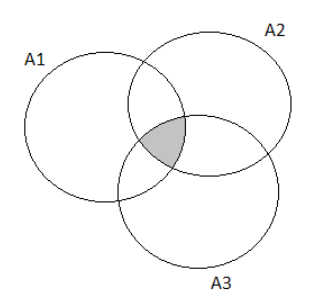
Page 55 Problem 15 Answer
Given: An engineering construction firm is currently working on power plants at three different sites.
A{i} denotes the event that the plant at site i is completed by the contract date.
Given event: Only the plant at site 1 is completed by the contract date.
To use the operations of union, intersection, and complementation to describe each of the following events in terms of A{1},A{2}, and A{3}
To draw a Venn diagram, and shade the region corresponding to given event.
In order to get only the plant at site 1 to be completed by the contract date, we will define the event as A1A2′∩A3′
Its Venn diagram is as follows:

The event that only the plant at site 1 is completed by the contract date is given by: A1∩A2′∩A3′
The required Venn diagram is:
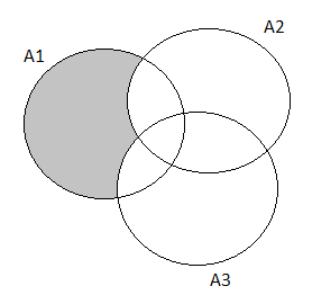
Page 55 Problem 16 Answer
Given: An engineering construction firm is currently working on power plants at three different sites.
A{i} denotes the event that the plant at site i is completed by the contract date.
Given event: Exactly one plant is completed by the contract date.Use the operations of union, intersection, and complementation to describe each of the following events in terms of A{1},A{2}, and A{3} .
To draw a Venn diagram, and shade the region corresponding to given event.
We have to get exactly one plant to be completed by the contract date we define the event which is represented as(A1∩A2′∩A3′)∪(A1′∩A2∩A3′)∪(A1′∩A2′∩A3).
From part c) we can say that if only plant at site 1 is completed by that contract data then we get A1∩A2′∩A3′
Here, the plant site is not defined rather we just need that exactly one plant is completed by the contract date.
It doesn’t matter that the plant is of which site. We can add all three possibilities A1
∩A2′∩A3′ (site 1)A1′∩A2∩A3′,(site 2),A1′∩A2′∩A3 (site 3).
Hence, event is represented as (A1∩A2′∩A3′)∪(A1′∩A2∩A3′)∪(A1′∩A2′∩A3)
Its Venn diagram is represented below:

The event that exactly one plant is completed by the contract date is given by: (A1
∩A2′∩A3′)∪(A1′∩A2∩A3′)∪(A1′∩A2′∩A3)
The required Venn diagram is:

Page 55 Problem 17 Answer
Given: An engineering construction firm is currently working on power plants at three different sites.
A{i} denotes the event that the plant at site i is completed by the contract date.
Given event: Either the plant at site 1 or both of the other two plants are completed by the contract date.
To use the operations of union, intersection, and complementation to describe each of the following events in terms of A{1},A{2}, and A{3}, To draw a Venn diagram, and shade the region corresponding to given event.
In order to show that either the plant at site 1 or both of the other two plants are completed by the contract date, we will define an event which is represented as A1∪(A2∩A3).
This is because “or” means union and “and” means intersection.
Hence the Venn diagram is:
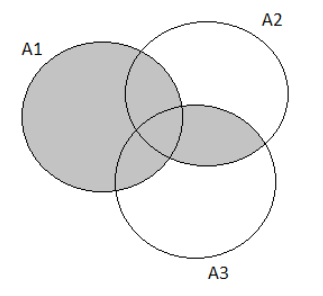
The event that either the plant at site 1or both of the other two plants are completed by the contract date is given by: A1∪(A2∩A3)
The required Venn diagram is:

Page 55 Problem 18 Answer
Given relationship for two events A and B: (A∪B)′=A′∩B′
To use a Venn diagram to verify the relationship.We will draw Venn diagram for both the events and show that it is equal.
We first construct(A∪B)′ as Venn diagram. It is the complement of A union B. the diagram below, the shaded area represents the left side(A∪B)′
Now, we will construct A′ and B′ as follows:
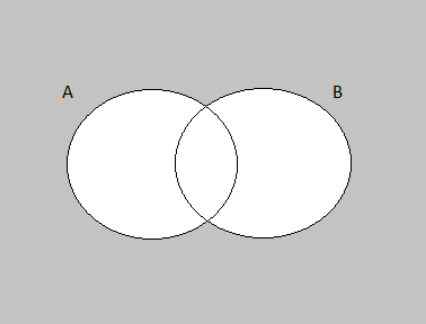 .
.
A′is represented by horizontal stripes.
A′is represented by vertical stripes.
The Venn diagram will look like:

Hence we can see that both the Venn diagrams are equal.
We have verified the relationship (A∪B)′=A′∩B′
by using Venn diagram.
Page 55 Problem 19 Answer
Given relationship for two events :(A∩B)′=A′∪B′
To use a Venn diagram to verify the relationship.We will draw Venn diagram for both the events and show that it is equal.
The shaded region in the given diagram represents(A∩B)′.

And A′∪B′ is represented by the area that has horizontal and vertical lines.
Hence we can see that both the Venn diagrams are equal.
We have verified the relationship (A∩B)′=A′∪B′ using Venn diagrams.
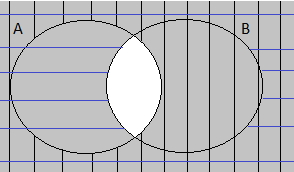
Page 55 Problem 20 Answer
Given example 2.10: A={Chevrolet, Pontiac, Buick }
B={Ford, Mercedes }
C={Lincoln, Chrysler }
To identity three events that are mutually exclusive.We will have to find the events whose intersection is a null set.
If A∩B=ϕ where A and B are two events then we can say that they are mutually exclusive.
Now, the events from example 2.10 are:
A= {Chevrolet, Pontiac, Buick}
B={Ford, Mercedes}
C={Lincoln, Chrysler}
We can see that all the name card are car brand and their intersection is empty.
Hence, they are mutually exclusive.
Then, A∩B=∅and A∩C=∅and B∩C=∅
The mutually exclusive events are:
A={Chevrolet, Pontiac, Buick}
B={Ford, Mercedes}
C= {Lincoln, Chrysler}
Page 55 Problem 21 Answer
Given in example 2.10:
A={Chevrolet, Pontiac, Buick }
B={Ford, Mercedes }
C={Lincoln, Chrysler }
Given: No outcome common to all the three events.To determine if the three events will be mutually exclusive.We will give a counter example.
If there is no outcome common to all three of the events A,B ,and C then these three events will not necessarily mutually exclusive.
For that lets take a counter example that is:
A1={Chevrolet, Buick}
B1={Buick, Mercedes}
C1={Mercedes, Lincoln}
As we can see that in A1 and B1 have Buick in common and in B1 and C1 have Mercedes in common which implies that are not mutually exclusive and there is no common car in all three events.
No. The three events are not necessarily mutually exclusive where there is no outcome common to all three of the events A,B, and C.
